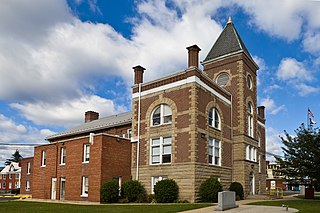
The Western Maryland Railway was an American Class I railroad (1852–1983) which operated in Maryland, West Virginia, and Pennsylvania. It was primarily a coal hauling and freight railroad, with a small passenger train operation.

There are more than 1,500 properties and districts listed on the National Register of Historic Places in the U.S. State of Maryland. Each of the state's 23 counties and its one county-equivalent has at least 20 listings on the National Register.

The CSX Susquehanna River Bridge is a railroad bridge that carries CSX's Philadelphia Subdivision across the Susquehanna River between Havre de Grace and Perryville, Maryland, via Garrett Island. It was built in 1907-10 by the Baltimore and Ohio Railroad (B&O) on the same alignment as an 1886 B&O bridge. Like its predecessor, it was the longest continuous bridge on the B&O system.

The Carrollton Viaduct, located over the Gwynns Falls stream near Carroll Park in southwest Baltimore, Maryland, is the first stone masonry bridge built for railroad use in the United States for the Baltimore and Ohio Railroad, founded 1827, with construction beginning the following year and completed 1829. Named for Charles Carroll of Carrollton (1737-1832), of Maryland, last surviving signer of the Declaration of Independence for the United States on July 4th, 1776 at Independence Hall in the new capital city of Philadelphia, Pennsylvania. The only Roman Catholic in the Second Continental Congress (1775-1781), and wealthiest man in the Thirteen Colonies of the new United States of America at the time. The American Revolutionary War (1775-1783) was beginning to rage with the organization of a Continental Army under command of General George Washington (1732-1799), of neighboring Virginia against the ruling Kingdom of Great Britain with its dominant British Army and Royal Navy.

The Thomas Viaduct spans the Patapsco River and Patapsco Valley between Relay, Maryland and Elkridge, Maryland, USA. It was commissioned by the Baltimore and Ohio Railroad (B&O); built between July 4, 1833, and July 4, 1835; and named for Philip E. Thomas, the company's first president.

The Patterson Viaduct was built by the Baltimore and Ohio Railroad (B&O) as part of its Old Main Line during May to December 1829. The viaduct spanned the Patapsco River at Ilchester, Maryland. It was heavily damaged by a flood in 1866 and subsequently replaced with other structures.

The Casselman Bridge is an historic transportation structure located 0.5 miles (0.80 km) east of Grantsville in Garrett County, Maryland. The bridge was built to carry the National Road across the Casselman River. Historic markers posted at each end read:
Erected 1813 by David Shriver, Jr.,
Sup't of the "Cumberland Road". This 80 foot span
was the largest stone arch in America
at the time. It was continuously
used from 1813 to 1933.

The Ellicott City Station in Ellicott City, Maryland, is the oldest remaining passenger train station in the United States, and one of the oldest in the world. It was built in 1830 as the terminus of the Baltimore and Ohio Railroad line from Baltimore to the town then called Ellicott's Mills, and a facility to service steam locomotives at the end of the 13-mile (21 km) run. The station, a National Historic Landmark, is now used as a museum.

The Rosalia Railroad Bridge was built by the Chicago, Milwaukee, St. Paul and Pacific Railroad in 1915 to replace an earlier timber trestle. The bridge was designed as a concrete arch, unusual for a railroad bridge, because it crosses the Northern Pacific Railroad tracks, a state highway, and is visible from Steptoe Battlefield State Park. The railroad wanted an impressive-looking bridge. The viaduct consists of two spans, separated by an embankment. East of the 334-foot (102 m) embankment there is a 114-foot (35 m) span crossing over the Northern Pacific tracks. To the west is a 502-foot (153 m) span that crosses Pine Creek, railroad tracks, and the highway.

The Loys Station Covered Bridge is a multiple king post wooden covered bridge near Thurmont, Maryland. The bridge was burned by an arsonist in 1991 and rebuilt using surviving framing. The original bridge spanned 90 feet in one span, but has since been modified with a pier at the middle of the span. The bridge crosses Owen's Creek and is surrounded by a park.
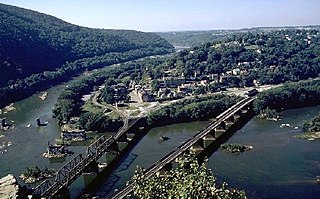
The Baltimore and Ohio Railroad Crossings at the Potomac River are a set of railroad bridges that span the Potomac River between Maryland Heights, Maryland and Harpers Ferry, West Virginia in the United States.

For the historic district in Brunswick, Georgia see Brunswick Old Town Historic District

The Garrett Park Historic District is a national historic district located at Garrett Park, Montgomery County, Maryland. It's a 154-acre (62 ha) residential community incorporated in 1891, along the B & O Railroad. The older community includes a number of late Victorian homes. During the 1920s, the town expanded with a set of 40,640-square-foot (3,776 m2), "Chevy" houses built by Maddux, Marshall & Co. The district also includes a set of Prairie Style homes designed and built by Alexander Richter during the 1950s.

Oakland station is a historic railroad station located at Oakland, Garrett County, Maryland. It is a large brick structure with a two-story central section featuring a cylindrical tower with a domed cap and one-story wings extending from each end along the railroad tracks. It was designed by Baldwin and Pennington, and built in 1884 by the Baltimore and Ohio Railroad across the tracks and a meadow from the Railroad's Oakland Hotel, which opened in 1876, to support the development of Oakland and Garrett County as a resort area. It is one of the finest remaining examples in Maryland of a Queen Anne style railroad station.
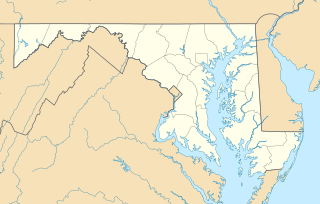
Borderside, also known as Brydon Mansion, was a historic home located at Bloomington, Garrett County, Maryland, United States. It was a 2 1⁄2-story, with 3-story tower, Italianate style brick structure that burned in the mid- to late 1970s. The tower had a pronounced bell-curve Mansard roof. It was built in 1870 for William A. Brydon, a coal and lumber dealer and member of the Maryland House of Delegates in 1867.
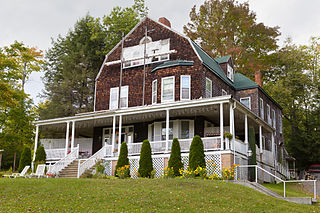
The Pennington Cottage is a historic home located at Deer Park, Garrett County, Maryland, United States. It is a 2 1⁄2-story, late-19th-century Shingle-Style frame structure, with a gambrel roof and a one-story porch that stretches across the principal facade and along portions of the sides. The house is entirely covered with dark wood shingles. It was built as a part of the Baltimore and Ohio Railroad's Deer Park Hotel complex, as the summer home of Baltimore architect Josias Pennington.

Union Bridge station is a historic railway station in Union Bridge, Carroll County, Maryland. It was built in 1902 as a stop for the Western Maryland Railway. It is representative of the rural railway stations constructed during the late 19th and early 20th centuries. The station's two buildings are arranged with their south façades lengthwise fronting the railroad tracks.
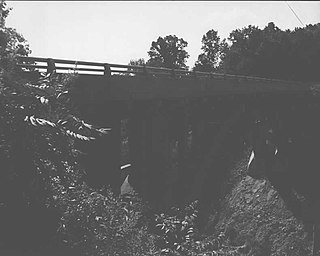
Colwell Cut Viaduct, also known as Hogback Hill Bridge, is a historic concrete arch bridge located at Mahoning Township in Armstrong County, Pennsylvania. It was built in 1922, and is a 220-foot-long (67 m) three-span bridge, with a 128-foot-long (39 m) main span. It crosses the Pittsburg and Shawmut Railroad.

The Adair Viaduct is a historic structure located in Adair, Iowa, United States. It spans the Iowa Interstate Railroad tracks for 192 feet (59 m). In 1908 Adair County built the first bridge at this location over the Chicago, Rock Island and Pacific Railroad tracks near the site of the 1873 Jesse James train robbery. Increased traffic by the 1920s necessitated its replacement. The Iowa State Highway Commission designed the three-span open spandrel arch bridge. The Adair County Board of Supervisors awarded the $42,263 to build the bridge to the Federal Bridge Company of Des Moines. It is somewhat unusual in Iowa in that the bridge is not symmetrical. Because it is located over a deep cut the two approach spans at 56 feet (17 m) each are shorter than the main span, which is 80 feet (24 m). The bridge was opened to traffic in June 1924. It was listed on the National Register of Historic Places in 1998.


